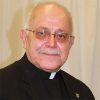Why do you Catholics worship the Virgin Mary?” is a question asked regularly, both online and in real life, by the curious and the critical. The answer — taught in most catechism classes — is simply, “We don’t.” We offer this explanation: “We worship God. We venerate the Blessed Virgin Mary and other saints.”
It’s true that the Roman Catholic and Eastern Orthodox Churches are unmatched in our zeal for honoring the Blessed Virgin Mary. Episcopalians and other Anglicans come next, followed by Lutherans. Even Muslims honor Miriam, Mother of Jesus the Messiah. In fact, the Qur’an dedicates an entire chapter to her — the only woman so honored, calling her “the greatest woman who ever lived.”
And to be sure, throughout history some Catholic individuals and groups have gone overboard in venerating the Blessed Mother.
But the two millennia-old veneration that Catholics and Orthodox afford to Mary is deeply rooted in Sacred Scripture.
Returning to biblical sources can correct distorted images of the mother of Jesus. The fiery Mary described in the Gospels, who proclaimed “He has cast down the mighty from their thrones, and has lifted up the lowly” (Luke 1:52) is a far cry from the passive, demure caricature portrayed in some pious Marian devotions.
Of all of Mary’s titles, none is more dynamic or profound than kecharitomene, which Catholic bibles translate as “full of grace.” This unique word, coined by St. Luke in his Gospel, is found nowhere else, neither in the Scriptures nor in Greek literature of the time. A unique word for a unique woman! It conveys the meaning that God had already highly favored, or graced, Mary — even before the Angel Gabriel greeted her. It is an adjective that denotes a permanent state of being; a condition in the present that is the result of a past action. We find in this word the biblical underpinning for the dogma of the Immaculate Conception: Mary was free from sin from the first moments of her existence.
This singular state of grace bore fruit in the Incarnation: God became human through Mary. At the Council of Ephesus in 431 A.D., the Church conferred on Mary the sublime title Theotokos, meaning “God-bearer” or in contemporary English, “Mother of God.”
Christians, especially women and mothers, find in Mary the strength to get through hardships. The Mater Dolorosa (Sorrowful Mother) consoles parents who tragically lose their children and who, like her, must stand at the foot of the cross and watch their children suffer.
In recent years, genetic research has confirmed the emblematic ongoing closeness between a mother and child. Medical science has discovered a phenomenon called “microchimerism:” as early as the second week of pregnancy, a two-way flow of chromosomes takes place between a mother and her unborn baby. Perhaps it’s not surprising that a mother’s cells cross the placenta to enter the fetus’ bloodstream. It is astonishing, however, that cells from the fetus also cross the placenta to enter into the mother’s bloodstream. Even after she gives birth, these new cells remain in the mother’s system. They have been found to treat, if not cure, allergies and even rheumatoid arthritis in the mother.
No wonder Christian cultures throughout history and around the world have found in Mary a mother, calling her by many titles and names in our own languages. And isn’t that also true to the Scriptures? “From this day all generations will call me blessed.” (Luke 1:48)
So, far more than being a surrogate mother for the Messiah, we are right to venerate Mary who — even now — continues to be the Theotokos, “God-bearer” for us and for the world.
Featured image: In the painting “Madonna and Child with Angels” by Italian artist Giovanni Battista da Salvi (1609-1685), the Virgin Mary tenderly embraces Jesus. (Wikimedia Commons)
![]()

